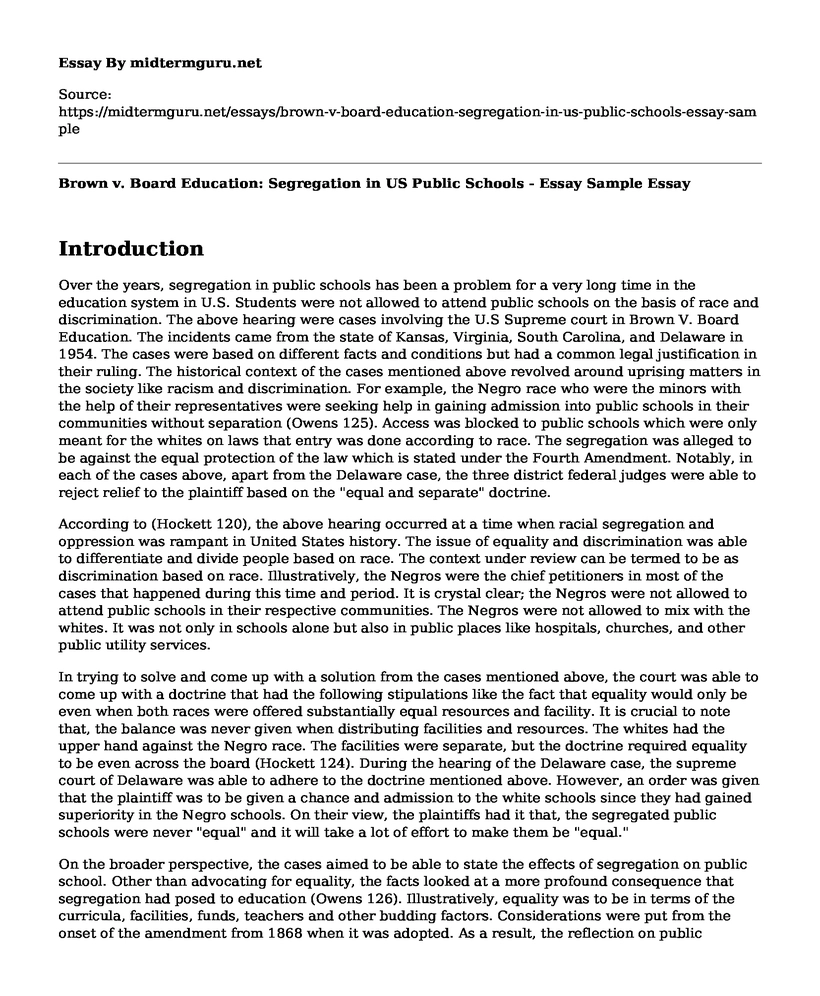Introduction
Over the years, segregation in public schools has been a problem for a very long time in the education system in U.S. Students were not allowed to attend public schools on the basis of race and discrimination. The above hearing were cases involving the U.S Supreme court in Brown V. Board Education. The incidents came from the state of Kansas, Virginia, South Carolina, and Delaware in 1954. The cases were based on different facts and conditions but had a common legal justification in their ruling. The historical context of the cases mentioned above revolved around uprising matters in the society like racism and discrimination. For example, the Negro race who were the minors with the help of their representatives were seeking help in gaining admission into public schools in their communities without separation (Owens 125). Access was blocked to public schools which were only meant for the whites on laws that entry was done according to race. The segregation was alleged to be against the equal protection of the law which is stated under the Fourth Amendment. Notably, in each of the cases above, apart from the Delaware case, the three district federal judges were able to reject relief to the plaintiff based on the "equal and separate" doctrine.
According to (Hockett 120), the above hearing occurred at a time when racial segregation and oppression was rampant in United States history. The issue of equality and discrimination was able to differentiate and divide people based on race. The context under review can be termed to be as discrimination based on race. Illustratively, the Negros were the chief petitioners in most of the cases that happened during this time and period. It is crystal clear; the Negros were not allowed to attend public schools in their respective communities. The Negros were not allowed to mix with the whites. It was not only in schools alone but also in public places like hospitals, churches, and other public utility services.
In trying to solve and come up with a solution from the cases mentioned above, the court was able to come up with a doctrine that had the following stipulations like the fact that equality would only be even when both races were offered substantially equal resources and facility. It is crucial to note that, the balance was never given when distributing facilities and resources. The whites had the upper hand against the Negro race. The facilities were separate, but the doctrine required equality to be even across the board (Hockett 124). During the hearing of the Delaware case, the supreme court of Delaware was able to adhere to the doctrine mentioned above. However, an order was given that the plaintiff was to be given a chance and admission to the white schools since they had gained superiority in the Negro schools. On their view, the plaintiffs had it that, the segregated public schools were never "equal" and it will take a lot of effort to make them be "equal."
On the broader perspective, the cases aimed to be able to state the effects of segregation on public school. Other than advocating for equality, the facts looked at a more profound consequence that segregation had posed to education (Owens 126). Illustratively, equality was to be in terms of the curricula, facilities, funds, teachers and other budding factors. Considerations were put from the onset of the amendment from 1868 when it was adopted. As a result, the reflection on public education was on the light and development of education and how it will be of more significant impact on the life of the Americans (Owens 128). By using this approach, we can be able to determine if segregation in public schools affects the plaintiffs about the protection of the law. In contemporary society, education is the most fundamental task to the local and federal government. Education as a fundamental right and the support in promoting learning and equality in education gives an impression of the support and significance of education to society.
Conclusion
In conclusion, the plight of public education about segregation has brought a lot of controversy on our stand to fund and provide education to the people thoroughly. The document fits well in the historical context and gives an impression of the challenges that education is facing. From the time in memorial, education has taken a lot of time to thrive and grow compared to other institutions in society. Not until such vices like segregation in public education, discrimination and equality have been solved; education has still a long mileage to take.
Works Cited
Hockett, Jeffrey D. "Brown v. Board of Education and the Symbolic Uses of Supreme Court Decisions in American Politics." Juris Poiesis 20.23 (2017): 68-124.
Owens, Jenna. "A Step Toward Brown V. Board Of Education: Ada Lois Sipuel Fisher and Her Fight to End Segregation." Oklahoma Politics 25 (2016): 125-128.
Cite this page
Brown v. Board Education: Segregation in US Public Schools - Essay Sample. (2022, Dec 26). Retrieved from https://midtermguru.com/essays/brown-v-board-education-segregation-in-us-public-schools-essay-sample
If you are the original author of this essay and no longer wish to have it published on the midtermguru.com website, please click below to request its removal:
- Mental Health and Risk of Offending
- Essay Example: Tobacco and Caffeine in the Chemistry of Everyday Life
- Essay Sample on Unemployment in South Korea
- How Could Medical Marijuana Potentially Help Louisiana? - Research Paper
- Religion in Schools: Enhancing Student Well-Being? - Research Paper
- Education: Basis for Human Development & Emancipation - Essay Sample
- Feminist Literature Analysis Essay on Charlotte Perkins Gilman's the Yellow Wallpaper







